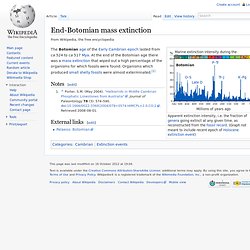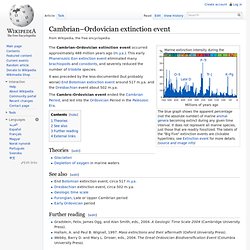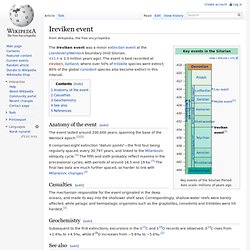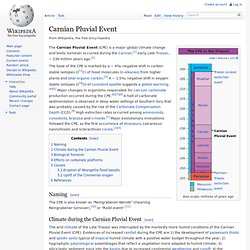

Great Oxygenation Event: 2400mya. O2 build-up in the Earth's atmosphere.

Red and green lines represent the range of the estimates while time is measured in billions of years ago (Ga). Stage 1 (3.85–2.45 Ga): Practically no O2 in the atmosphere. Stage 2 (2.45–1.85 Ga): O2 produced, but absorbed in oceans & seabed rock. Stage 3 (1.85–0.85 Ga): O2 starts to gas out of the oceans, but is absorbed by land surfaces.
Stages 4 & 5 (0.85–present): O2 sinks filled and the gas accumulates.[1] Cyanobacteria, which appeared about 200 million years before the GOE,[3] began producing oxygen by photosynthesis. End-Ediacaran extinction: 542mya. Evidence suggesting that a mass extinction occurred at the end of the Ediacaran period, 542 million years ago, includes: A mass extinction of acritarchsThe sudden disappearance of the Ediacara biota and calcifying organisms;The time gap before Cambrian organisms "replaced" them.

Pre-Ediacaran organisms[edit] During the Ediacaran period, two main groups of organisms are found in the fossil record: the "Ediacara biota" of soft-bodied organisms, preserved by microbial mats; and calcifying organisms such as Cloudina and Namacalathus, which had a carbonate skeleton.[1] Because both these groups disappear abruptly at the end of the Ediacaran period, 542 ± 0.3 million years ago, their disappearance cannot simply represent the closure of a preservational window,[2] as had previously been suspected.[1] Post-Ediacaran organisms[edit]
End-Botomian mass extinction: : 524-517mya. Botomian Millions of years ago Notes[edit] External links[edit] Palaeos: Botomian.

Cambrian–Ordovician extinction event: 488mya. The blue graph shows the apparent percentage (not the absolute number) of marine animalgenera becoming extinct during any given time interval.

It does not represent all marine species, just those that are readily fossilized. The labels of the "Big Five" extinction events are clickable hyperlinks; see Extinction event for more details. (source and image info) It was preceded by the less-documented (but probably worse) End Botomian extinction event around 517 m.y.a. and the Dresbachian event about 502 m.y.a. Ireviken extinction event: 428mya : Anoxic. Key events in the Silurian Key events of the Silurian Period.

Axis scale: millions of years ago. The Ireviken event was a minor extinction event at the Llandovery/Wenlock boundary (mid Silurian, 433.4 ± 2.3 million years ago). The event is best recorded at Ireviken, Gotland, where over 50% of trilobite species went extinct; 80% of the global conodont species also become extinct in this interval. Mulde extinction event: 424mya : Anoxic. Key events in the Silurian Key events of the Silurian Period.

Axis scale: millions of years ago. The Mulde event was a secundo-secundo event,[3] and marked the second of three1 relatively minor mass extinctions during the Silurian period. It coincided with a global drop in sea level, and is closely followed by an excursion in geochemical isotopes. Its onset is synchronous with the deposition of the Fröel formation in Gotland.[3] Notes[edit] ^1 The Ireviken event and Lau event, other late Silurian extinction events, were both closely followed by isotopic excursions, as was the Mulde event. References[edit] Jump up ^ Jeppsson, L.; Calner, M. (2007). Lau extinction event: 420mya : Anoxic. Key events in the Silurian Key events of the Silurian Period.

Axis scale: millions of years ago. The Lau event was the last of three relatively minor mass extinctions during the Silurian period,[3] having a major effect on the conodont fauna (but barely scathing the graptolites). It coincided with a global low point in sea level, is closely followed by an excursion in geochemical isotopes in the ensuing late Ludfordian faunal stage and a change in depositional regime.[4] Biotic impact[edit] Isotopic effects[edit] A peak in δ13C, accompanied by fluctuations in other isotope concentrations, is often associated with mass extinctions.
Carboniferous Rainforest Collapse : 305mya. The Carboniferous rainforest collapse could have been the result of colder, drier climate Extinction patterns[edit] In the Carboniferous, the great tropical rainforests of Euramerica supported towering lycopsids, a heterogeneous mix of vegetation, as well as a great diversity of animal life: giant dragonflies, millipedes, cockroaches, amphibians, and the first reptiles.

Plants[edit] The rise of rainforests in the Carboniferous greatly altered the landscapes by eroding low-energy, organic-rich anastomosing river systems with multiple channels and stable alluvial islands. The continuing evolution of tree-like plants increased floodplain stability by the density of floodplain forests, the production of woody debris, and an increase in complexity and diversity of root assemblages.[2] Collapse occurred through a series of step changes. Olson's Extinction : 270mya. Olson's Extinction was a mass extinction that occurred 270 million years ago in the Early Guadalupian of the Permian period and which predated the Permian–Triassic extinction event.[1] Everett Olson noted[when?]

That there was a hiatus and a sudden change in between the Early Permian and Middle/Late Permian faunas. Since then this event has been realized across many groups, including plants, marine invertebrates, and tetrapods. Identification[edit] Carnian Pluvial Event :230mya. The CPE in the Triassic Axis scale: millions of years ago The Carnian Pluvial Event (CPE) is a major global climate change and biotic turnover occurred during the Carnian,[1] early Late Triassic, ~ 230 million years ago.[2]

Toarcian turnover :183mya. Aptian extinction : 116mya. Eocene–Oligocene extinction event : 33.5mya. Millions of years ago Eocene–Oligocene extinction is labeled E– OG. The 33.9 Ma transition between the end of the Eocene and the beginning of the Oligocene, called the Grande Coupure (the "Great Break" in continuity) in Europe, is marked by large-scale extinction and floral and faunal turnover (although minor in comparison to the largest mass extinctions).
Most of the affected organisms were marine or aquatic in nature. They included the last of the ancient cetaceans, the Archaeoceti. This was a time of major climatic change, especially cooling, not obviously linked with any single major impact or any catastrophic volcanic event. This boundary is closely linked with the Oligocene Oi-1 event, an oxygen isotope excursion that marks the beginning of ice sheet coverage on Antarctica. Grande Coupure[edit] The Grande Coupure marks a break between endemic European faunas before the break and mixed faunas with a strong Asian component afterwards. Middle Miocene disruption : 14.5mya. The term Middle Miocene disruption, alternatively the Middle Miocene extinction or Middle Miocene extinction peak, refers to a wave of extinctions of terrestrial and aquatic life forms that occurred around the middle of the Miocene, roughly 14.8 to 14.5 million years ago, during the Langhian stage of the Miocene.
Madelaine Bohme[1] observed the occurrence of Varanidae, Chameleon, Cordylidae, Tomistominae, Alligatoridae, and giant turtles which indicate survival through the Miocene Climatic Optimum (18 to 16 Ma) in Central Europe (45-42°N palaeolatitude). A major and permanent cooling step occurred between 14.8 and 14.1 Ma, associated with increased production of cold Antarctic deep waters and a major growth of the East Antarctic ice sheet. Two crocodiles of the genera Gavialosuchus and Diplocynodon were noted to have been extant in these northern latitudes prior to the permanent cooling step then became extinct 13.5 to 14 Ma.
Quaternary extinction event. The Quaternary period saw the extinctions of numerous predominantly larger, especially megafaunal, species, many of which occurred during the transition from the Pleistocene to the Holocene epoch. However, this extinction wave did not stop at the end of the Pleistocene, but continued, especially on isolated islands, in Holocene extinctions. Among the main causes hypothesized by paleontologists are natural climate change and overkill by humans, who appeared during the Middle Pleistocene and migrated to many regions of the world during the Late Pleistocene and Holocene. A variant of the latter possibility is the second-order predation hypothesis, which focuses more on the indirect damage caused by overcompetition with nonhuman predators. The spread of disease is also discussed as a possible reason. Holocene extinction.
Ongoing extinction event caused by human activity The Holocene extinction includes the disappearance of large land animals known as megafauna, starting at the end of the last Ice Age. Megafauna outside of the African continent, which did not evolve alongside humans, proved highly sensitive to the introduction of new predation, and many died out shortly after early humans began spreading and hunting across the Earth (many African species have also gone extinct in the Holocene, but —with few exceptions— megafauna of the mainland was largely unaffected until a few hundred years ago)[citation needed]. These extinctions, occurring near the Pleistocene–Holocene boundary, are sometimes referred to as the Quaternary extinction event.
Ecologically, humanity has been noted as an unprecedented "global superpredator"[10] that consistently preys on the adults of other apex predators, and has worldwide effects on food webs.